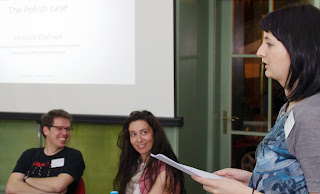 Chair: Aukseé Balčytiené
Chair: Aukseé Balčytiené, Vytautas Magnus University
Speakers
Nico Carpenter, Vrije Universiteit Brussels
Marko Ivanišin, University of Maribor
Patricia González Aldea, Carlos III. University of Madrid
Urzsula Doliwa, University of Warmia and Mazury
Nico Carpenter took the floor first, noting the efforts of Cyprian community media focusing on an enhancement of the peace process, moving then to the topic of post-cold war community media in CEE states. In his very transparent elaboration, he identified the main problem associated with community media, which lies in the lack of generally accepted definition:
„There is not one community media, there is not one label“, he stated. Ensuingly, he offered four possible perceptions of community media: 1) media serving to a certain community, 2) alternative media to the mainstream ones, 3) media which form a part of civic society, 4) media which serve as a network within the civil society actors. By the end of his presentation, he addressed some further challenges, underlining the fact that community media are
„difficult to capture in a legislation“.
Marko Ivanišin further elaborated on the issue of activist accent inherent to community media. He relied on the case of Mariborski radio študent (MARŠ) which was the first alternative to state-run electronic media in Slovenia, established in 1990. Although a student radio by name, MARŠ is in fact a community radio. After a succesful period, it faced serious funding problems, fighting for market share with not only state-run but also commercial radios. In 2005, the producers established a
„Society of MARŠ friends“ in order to save the radio. Mr. Ivanišin was a part of this effort and in his presentation he had recalled the international cases he surveyed in order to gain inspiration.
„The best example of student media is Okto TV from Vienna. It is almost professional and provides education to the participants“. By the end of his speech, Ivanišin addressed the discrepancies between the perception of the radio by its producers and the University of Maribor.
Dealing with the issue of Romanian ethnic media in Spain was
Patricia González Aldea of Madrid. Firstly recalling the Spanish multicultural reality (currently up to 900 000 Romanians living in Spain), she provided the audience with a general overview of the public opinion on minorities:
„According to a survey, Romanians were the worst perceived national minority in Spain“, she claimed. For a number of reasons, the importance of ethnic media is by the speaker supposed to be irreplacable – mostly because they can
„actively participate in promoting a sense of belonging and to generate a flow of empathy towards these citizens“.They also serve as a tool to maintain links with the reality of the communities' home countries. The most influential and oldest Romanian ethnic media in Spain called
Romanians in the World nowadays has full-colored lay-out and a Spanish version, informed Ms. Aldea.
Urzsula Doliwa shifted the scope of discussion once again to the CEE region, talking about Polish religious media. She stressed the specifically influential role of the Polish catholic church which uses various sorts of media for their promotion.
„In Poland, unlike the Czech Republic, catholic radios form a large share of the market“, the speaker stated. These radios broadcast both on regional and local levels and have both commercial and social statuses. „
All the eight Polish social broadcasters are connected to the church“, elaborated Ms. Doliwa further.
















